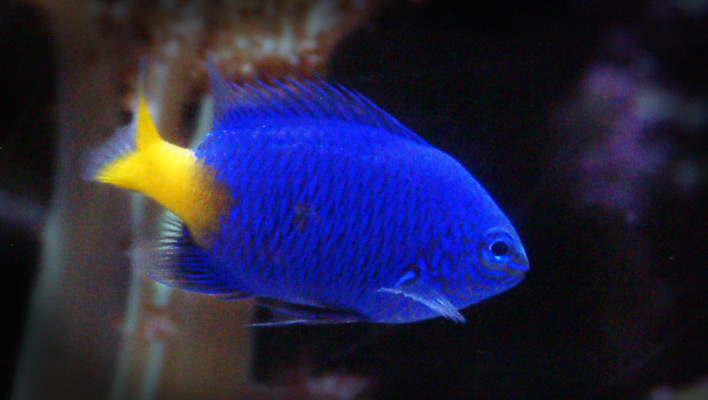Ask the average marine aquarium hobbyist to identify the most aggressive coral-reef fishes, and the damselfishes of the family Pomacentridae are likely to be placed somewhere very close to the top of the list. For many damsel species, the reputation for belligerence is well deserved. However, there are some noteworthy exceptions — damsels that are actually fairly docile and apt to coexist peacefully with a wide variety of tankmates. Among them is the popular yellowtail blue damsel (Chrysiptera parasema).
Physical characteristics
C. parasema is truly a gem of a fish. Its body is a lustrous blue overall. Depending on the lighting over the aquarium, this coloration can take on brighter or deeper hues or even appear purple or almost black. As the common name suggests, the tail and caudal peduncle are bright yellow. In some specimens, yellow may also appear on the anal fin and the trailing edge of the dorsal fin. The maximum length for this species is not quite 3 inches.
A practically perfect beginner fish
Few species are better suited to beginners than the yellowtail blue damsel. C. parasema is remarkably hardy, so it can usually weather the occasional water-quality missteps that beginner’s are prone to, and it will readily accept standard aquarium fare. Owing to its diminutive size and the fact that it doesn’t demand a great deal of open swimming space, it’s also a great choice for smaller aquariums (down to about 20 gallons).
Foods fit for the yellowtail blue damsel
C. parasema is omnivorous, and, therefore, its captive menu should include a good variety of both meaty and algae-based foods. Mysid shrimp, brine shrimp, finely chopped seafood, pellets, flakes, and various frozen formulations for omnivores and herbivores are just a sampling of the foods it will accept. Again, feeding is a snap and hunger strikes are rare with this species.
Suitable tankmates
While the usual conundrum when choosing tankmates for a damsel is finding species that won’t be tormented by the damsel, that problem is sort of turned on its head with C. parasema—you have be more wary of introducing aggressive tankmates that will pick on the yellowtail.
Now, that doesn’t mean that C. parasema is a complete Caspar Milquetoast. It’s a damsel, after all, and the rules of appropriate order of introduction still apply. Extremely shy, retiring species—especially those that are very similar in size and color, should be introduced before the yellowtail.
With respect to conspecifics, C. parasema is one of the few damsels that can be kept in groups. However, I would recommend attempting this only in larger systems with lots of rockwork to provide ample hiding places and disrupt the damsels’ line of sight.
The ideal reef resident
Not only is C. parasema a perfect choice for beginners, but it’s also an ideal candidate for reef systems. This diminutive gem of a damsel is completely inoffensive to corals and other sessile invertebrates and will have a minimal impact on the system’s bioload.



